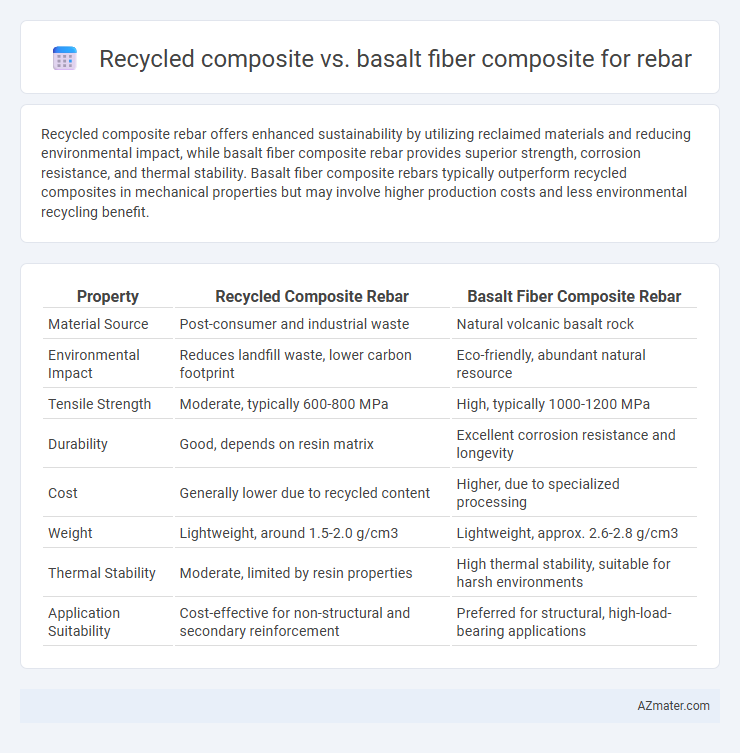Recycled composite rebar offers enhanced sustainability by utilizing reclaimed materials and reducing environmental impact, while basalt fiber composite rebar provides superior strength, corrosion resistance, and thermal stability. Basalt fiber composite rebars typically outperform recycled composites in mechanical properties but may involve higher production costs and less environmental recycling benefit.
Table of Comparison
| Property | Recycled Composite Rebar | Basalt Fiber Composite Rebar |
|---|---|---|
| Material Source | Post-consumer and industrial waste | Natural volcanic basalt rock |
| Environmental Impact | Reduces landfill waste, lower carbon footprint | Eco-friendly, abundant natural resource |
| Tensile Strength | Moderate, typically 600-800 MPa | High, typically 1000-1200 MPa |
| Durability | Good, depends on resin matrix | Excellent corrosion resistance and longevity |
| Cost | Generally lower due to recycled content | Higher, due to specialized processing |
| Weight | Lightweight, around 1.5-2.0 g/cm3 | Lightweight, approx. 2.6-2.8 g/cm3 |
| Thermal Stability | Moderate, limited by resin properties | High thermal stability, suitable for harsh environments |
| Application Suitability | Cost-effective for non-structural and secondary reinforcement | Preferred for structural, high-load-bearing applications |
Introduction to Composite Rebars: Market Trends and Materials
Composite rebars are increasingly favored in infrastructure due to superior corrosion resistance and high strength-to-weight ratios compared to traditional steel rebars. Recycled composites leverage waste materials to create sustainable reinforcements with reduced environmental impact, while basalt fiber composites offer exceptional durability, chemical resistance, and thermal stability. Market trends indicate a growing preference for basalt fiber rebars in aggressive environments, whereas recycled composites gain traction in eco-friendly construction projects prioritizing sustainability.
Understanding Recycled Composite Rebars
Recycled composite rebars offer enhanced sustainability by utilizing post-consumer or industrial waste materials, reducing landfill impact and conserving natural resources while maintaining structural integrity and corrosion resistance. These rebars provide comparable tensile strength and durability to conventional basalt fiber composites, with the added benefit of a lower environmental footprint and potential cost savings in large-scale construction applications. Understanding recycled composite rebars involves evaluating their mechanical performance, lifecycle environmental benefits, and compatibility with concrete in corrosive and high-stress environments.
Overview of Basalt Fiber Composite Rebars
Basalt fiber composite rebars are manufactured from continuous basalt fibers and offer high tensile strength, corrosion resistance, and lightweight properties compared to traditional steel and recycled composite rebars. These rebars exhibit superior thermal stability, chemical resistance, and durability in harsh environments, making them ideal for infrastructure exposed to moisture, chemicals, and extreme temperatures. Their eco-friendly nature and minimal environmental impact during production further position basalt fiber composite rebars as a sustainable alternative in modern construction projects.
Manufacturing Processes: Recycled vs. Basalt Fiber Composites
Manufacturing recycled composite rebar involves processing shredded plastic or composite waste through extrusion or pultrusion, emphasizing material reuse and reducing environmental impact. Basalt fiber composite rebar is produced by extruding molten basalt rock into fibers, which are then woven and impregnated with resin, resulting in superior tensile strength and corrosion resistance. Recycled composites prioritize sustainability by utilizing waste materials, while basalt fiber composites focus on high performance and durability in structural applications.
Mechanical Properties Comparison
Recycled composite rebar offers improved tensile strength and corrosion resistance compared to traditional steel rebar, with tensile strengths typically ranging between 600 to 900 MPa. Basalt fiber composite rebar demonstrates higher mechanical properties, including tensile strengths up to 1200 MPa and superior modulus of elasticity around 85 GPa, resulting in enhanced durability under cyclic loading. Both materials outperform conventional steel in corrosion resistance, but basalt fiber composites provide a better balance of stiffness, strength, and long-term mechanical stability for infrastructure applications.
Durability and Corrosion Resistance
Recycled composite rebars exhibit enhanced durability due to their resistance to environmental degradation and chemical exposure, making them suitable for long-term structural applications. Basalt fiber composites offer superior corrosion resistance compared to traditional steel, thanks to their inert mineral composition that prevents rust formation even in aggressive environments. Both materials provide significant lifespan advantages over conventional steel rebar, with basalt fiber composites often outperforming recycled composites in maintaining mechanical integrity under wet and corrosive conditions.
Environmental Impact and Sustainability
Recycled composite rebar significantly reduces environmental impact by utilizing waste materials, lowering carbon emissions, and diverting plastics from landfills, making it a sustainable choice for construction. Basalt fiber composite rebar offers durability and corrosion resistance with a lower carbon footprint compared to traditional steel, due to energy-efficient production from natural volcanic rock. Both materials contribute to sustainability, but recycled composites emphasize waste reduction while basalt fiber composites focus on long-term structural resilience and minimal environmental degradation.
Cost Analysis: Recycled vs. Basalt Fiber Composites
Recycled composite rebars generally offer a more cost-effective solution compared to basalt fiber composites due to lower raw material expenses and established recycling processes. Basalt fiber composites, while higher in initial cost, provide superior mechanical properties and durability that may reduce long-term maintenance expenses. Evaluating total life cycle costs, recycled composites deliver immediate budget relief, whereas basalt fiber composites justify investment through enhanced performance and longevity.
Application Areas: Suitability and Performance
Recycled composite rebars offer excellent corrosion resistance and environmental benefits, making them ideal for infrastructure projects in marine and chemically aggressive environments. Basalt fiber composites provide superior mechanical strength and thermal stability, suited for high-load structural applications such as bridges and high-rise buildings. Both materials enhance durability compared to traditional steel, with basalt fiber composites excelling in load-bearing performance and recycled composites favored for sustainable construction and retrofit projects.
Future Perspectives and Innovations in Composite Rebars
Recycled composite rebars offer sustainable advantages by utilizing waste materials, reducing environmental impact while maintaining structural integrity, making them a promising solution for eco-friendly construction. Basalt fiber composites provide superior corrosion resistance, high tensile strength, and thermal stability, which enhance longevity and reduce maintenance costs in infrastructure projects. Future innovations will likely integrate nanomaterials and smart sensing technologies into both recycled and basalt fiber composites to improve durability, real-time monitoring, and overall performance in rebar applications.

Infographic: Recycled composite vs Basalt fiber composite for Rebar
 azmater.com
azmater.com